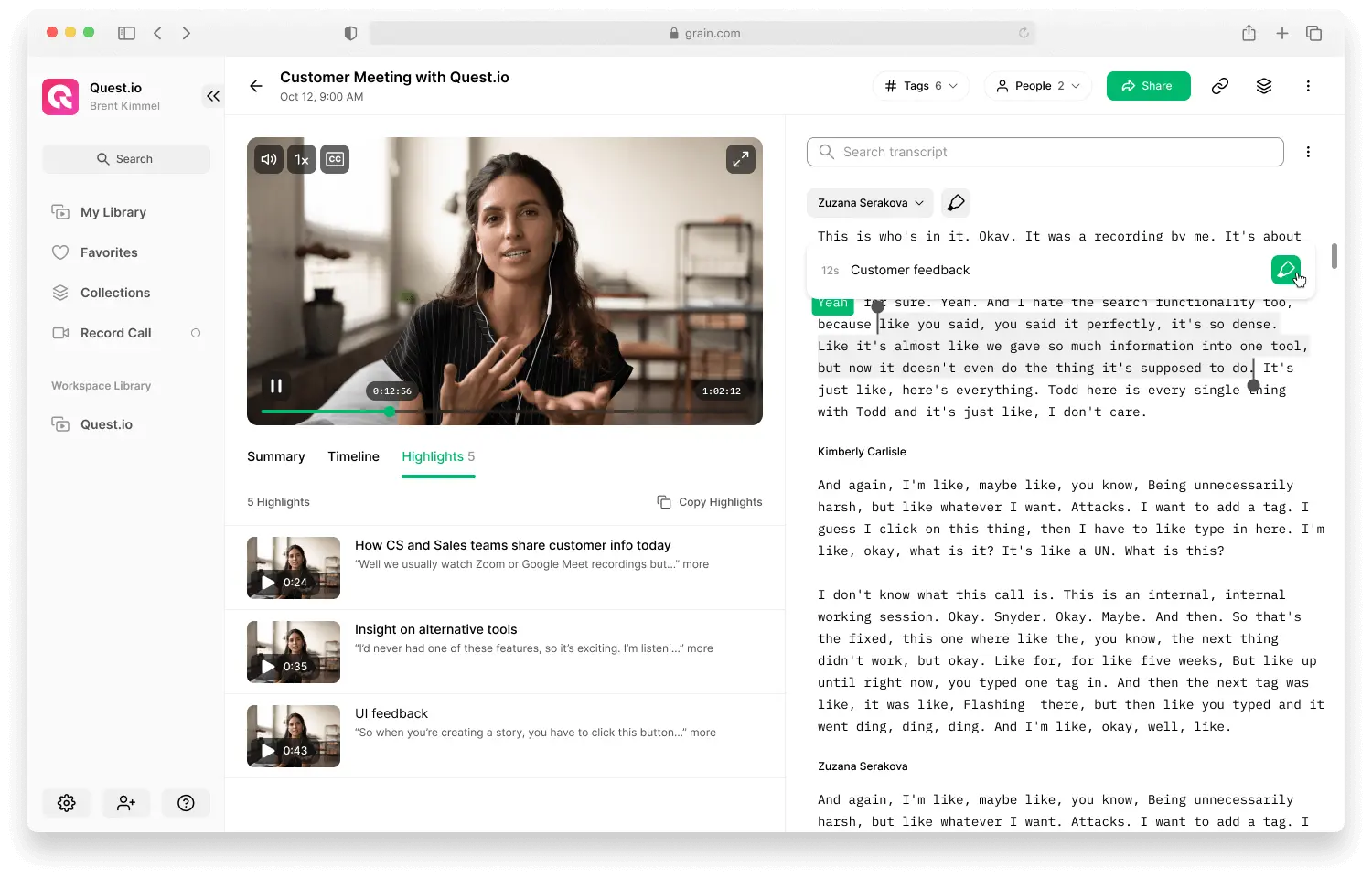5 Things to Do on Every Sales Call
Sales calls are hard. But without them, your job as a salesperson would be a lot harder. You'd be constantly chasing down leads, trying to get ahold of people who may or may not be interested in what you're selling, and generally spinning your wheels without ever making any real progress.
Simply put, while sales calls may not be the most fun part of the job, they're essential to close deals and reach your quotas. Yet, far too many salespeople go into calls without a clear plan or any real strategy for success. If you're looking to up your sales call game, here are 5 things to do on every single sales call, no matter who you're talking to or what you're selling.
1. Ask Interesting Questions
We all know the drill: you start with the basics, ask how the person's day is going, make some small talk, and then try to segue into the pitch.
But here's the thing: everyone knows what you're up to. They can see right through your thinly veiled attempt at getting to know them, which ultimately comes off as insincere.
Instead of going through the motions, take the time to ask interesting questions that will get the person talking. This shows that you're genuinely interested in getting to know them and gives you valuable information that you can use later in the conversation.
One way to do this is to make the questions specific to the person you're talking to. Generic questions that could apply to anyone are a waste of time, and they'll just make the person feel like they're being interviewed. So instead of asking, "What do you do?", try something like, "I saw on LinkedIn that you recently started a new job. How's the transition been?"
That's much better.
Then, as you transition into more sales-related questions, be sure to ask open-ended questions that can't be answered with a simple yes or no.
For example, instead of asking, "Are you interested in learning more about our product?", you could say, "What interests you most about the 'product category'?" Then, based on their answer, you can adjust your pitch to focus on the benefits that are most important to them.
By asking open-ended, tailored questions, you're breaking down barriers, building rapport, and gathering information that will help you close the deal.
2. Probe Emotions
One mistake that salespeople often make is that they focus too much on the logical aspects of the product they're selling. But the reality is that people make 90% of their decisions based on emotions, not logic.
If you want to have better sales calls, you need to focus on the emotions that your product or service evokes. This means exploring both the positive and negative emotions that are associated with the decision to buy.
For example, suppose you're selling a new CRM system to a small business owner. In that case, you might explore the positive emotions of relief and happiness that come with finally having an organized system for managing customer data. But you should also explore the negative emotions they're currently experiencing, like frustration and anxiety over the current state of their disorganized system.
While these are intangible benefits, they're the things that will ultimately make your product irresistible. People aren't interested in the features of your product–they're interested in the outcome, and that comes down to emotion.
To probe emotions, an effective technique is storytelling. Instead of simply listing the features and benefits of your product, tell a story that resonates with the person you're speaking to. For example, you might share a case study of another small business owner who was struggling with the same issues and how your product helped them turn things around.
This is also a perfect time to showcase social proof, like customer testimonials or reviews. If other people have had success with your product, that will go a long way towards easing the buyer's fears and making them feel more comfortable about making a purchase.
3. Frame the Product Correctly
There's always more than one way to frame a product or service. And depending on how you do it, you can either make it more appealing or less so.
For example, let's say you're selling a new software program that helps businesses track their expenses. You could frame it as another boring accounting tool, or you could frame it as a way to save money and reduce stress. The first option is much less appealing than the second.
Why? Because the second one packages the product in a way that's relevant to the buyer and their needs.
It's not just about the product's features but also about how those features can help them in their life or business. It presents the product as a solution, not just another thing to buy.
When framing the product, think about the buyer's real needs and how your product can help them meet those needs. Again, don't just focus on the features–focus on the outcome.
Pro Tip: If you're not sure what your specific prospect's pain points are, do some research before the call. Look at their website, social media, and any other publicly available information. This will give you a good idea of what they're struggling with and how your product can help.
4. Subtly Address Objections
Whenever you're making a sales pitch, there will always be objections—it's just a natural part of the process. And the best way to deal with them is to address them head-on before they even come up.
This doesn't mean that you need to list out every objection they could possibly have–just hit the big ones, such as:
- Will this work for me?
- What if I don't have the time/money for this?
- I'm not sure I'm ready to make a change yet.
- What if I try this and it doesn't work?
To address these objections, you can use risk-reversal language. This is basically when you shift the risk from the buyer onto yourself. For example, you might say something like, "I'm so confident that this will work for you that I'm willing to offer a money-back guarantee."
Or, "I know you're busy, so I've put together a quick start guide that will help you get up and running in no time." Or, "To give you peace of mind, I'm offering a free consultation so you can see for yourself how this would work in your specific situation."
Words and phrases like "money-back guarantee", "up and running in no time", "easy opt-outs", "no contracts", and so on are all meant to ease the buyer's fears and make them feel more comfortable about taking the next step.
And they work. When salespeople use risk-reversal language, they boost their sales win rates by 32% on average. So plan to use it on your next call.
5. Capture and Use Insights From Sales Calls
Not too long ago, sales reps would have to rely on memory (or maybe some notes scribbled on a piece of paper) to remember what happened during a sales call.
The result?
A lot of insights and information got lost in the shuffle. Or worse, prospects didn't feel like they were being listened to because the sales rep couldn't remember what they'd said or were too busy taking notes to engage.
Fortunately, today, there's a much better way to capture and use insights from sales calls: automatic call recording.
There are now several different call recording and transcription tools available that make it easy to capture every word that was said during a sales call. And once you have that information, you can use it to improve future calls.
For instance, if you scheduled a follow-up call and want to pick up where you left off, you can quickly review the transcript and see exactly what was said. This way, you won't have to waste time trying to remember what happened–you can just jump right back in.
You can also use sales call recordings to listen for any objections that came up during the conversation. This will give you a chance to address those objections head-on the next time around.
If you’re looking for a call recording tool, try Grain. Grain helps you record your sales calls—and build a video library of customer and market knowledge. You can also transcribe, annotate, clip, and share key moments with your team—instantly.

Through a shared workspace featuring a library of all your past recordings, you can easily review and search through the conversations—so you never have to worry about forgetting what was said again and always stay prepared for your next call. On top of it, Grain can help you onboard and coach new sales reps in less time.

Bonus Tip: Plan for the Next Follow-Up Meeting
We couldn't have a blog post about sales call tips without including at least one follow-up tip.
When you're wrapping up a sales call, it's important to take a few minutes to plan for the next meeting. The "traditional closing" of trying to get the prospect to commit to a purchase right then and there is no longer effective. Prospects want time to think about your product and do their research.
Similarly, generic wrap-ups like, "It was great talking to you; we'll touch base soon," are also ineffective. The prospect will likely forget all about the conversation (and you) by the time you "touch base".
Instead, get specific about when and how you'll follow up. For instance, you might say something like, "I'll shoot you an email tomorrow with the information we discussed, and we can set up a time for a brief call next week to answer any questions you might have."
Or, "Next time we talk, I want to hear about your thoughts on X and Y." This shows that you're paying attention to the conversation and are invested in continuing it.
This may seem like a small thing, but by being specific about the next meeting, you're letting the prospect know exactly what to expect and when–and they're more likely to move forward with the sale. Put yourself in their shoes: wouldn't you appreciate this level of clarity, too?
Closing Thoughts
There's no doubt that sales calls are a crucial part of the sales process. But if you're not prepared or don't have a solid plan going into the call, it's easy for things to go off the rails. The solution isn't to avoid sales calls altogether, it's to be smarter about how you approach them.
When you put your all into every sales call and prioritize your prospect's needs, you're much more likely to come out of the call with a win. And by using sales call analysis software like Grain to record and transcribe your sales calls, you can ensure that you never miss a beat (or forget what was said).
Go into your next sales call armed with these tips and see how they help you close more deals and build better relationships with your prospects.



.png)



